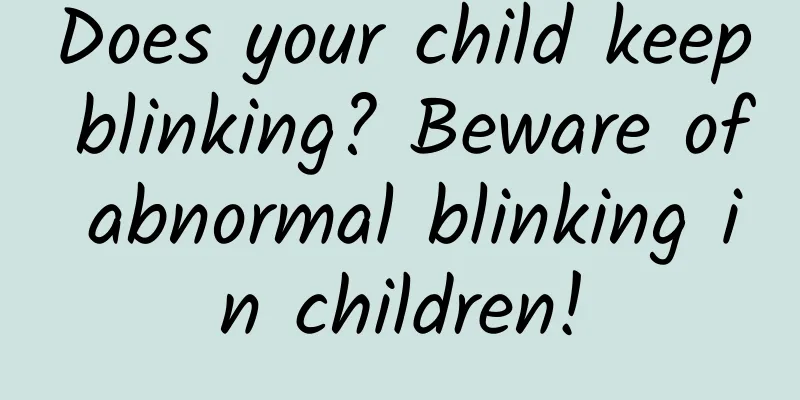Does your child keep blinking? Beware of abnormal blinking in children!

|
Author: Chen Tingliang Shenzhen Children's Hospital Reviewer: Chen Lingyan, Chief Physician, Shenzhen Children's Hospital Xiao Rui's careful mother noticed some subtle changes in 4-year-old Xiao Rui recently - Xiao Rui blinked more frequently than before. At first, she thought Xiao Rui was just mischievously imitating, but as time went on, Xiao Rui's blinking did not improve, but became more frequent. Xiao Rui's mother was full of doubts and took Xiao Rui to the ophthalmology department of the hospital for treatment. The ophthalmologist used a medical term to explain Xiao Rui's abnormality, namely "childhood abnormal blinking syndrome." Figure 1 Copyright image, no permission to reprint 1. Normal Blink vs. Abnormal Blink In fact, normal blinking (i.e. blinking) is very important for maintaining eye health. It is a physiological reflex action with the following functions. 1. Lubricate the eyeball: Every time you blink, the upper and lower eyelids will evenly spread tears on the surface of the cornea and conjunctiva to form a thin film (ie, tear film) to prevent the eyes from drying out. 2. Remove foreign matter: Tears contain antibacterial ingredients that can wash away small particles or other foreign matter that enter the eyes, thereby protecting the eyes from infection. 3. Maintain clear vision: Blinking helps keep the surface of the eyeball smooth, and the even distribution of the tear film helps light pass through the cornea better, thereby maintaining good visual clarity. 4. Relieve eye fatigue: After staring at a computer screen for a long time or doing other close-up eye work, people tend to blink less, leading to dry eyes and fatigue. Regular blinking can help relieve this discomfort. In daily life, people usually blink about 15 times per minute. When children blink frequently, more than 15 times per minute, or even with a brief eye closure, it is called abnormal blinking in children. This is a non-organic eye disease, which has been gradually increasing in clinical practice in recent years. If combined with organic eye lesions or neurological diseases, it is called childhood blink syndrome. 2. What causes children to blink abnormally? The causes of abnormal blink in children are complex and diverse, including but not limited to the following aspects. 1. Eye diseases: such as conjunctivitis, keratitis, trichiasis, dry eyes, etc. The eye discomfort or irritation caused by these diseases often prompts children to blink frequently to relieve the discomfort. In addition, people with refractive errors will try to adjust the focus by blinking frequently when their vision is blurred. 2. Bad eye habits: Using eyes at close range for a long time, such as watching electronic screens, reading books, etc., will cause tension in the eye muscles, thereby increasing the frequency of blinking. 3. Neurological abnormalities: Abnormal blinking in some children may be related to incomplete or abnormal development of the nervous system, such as tic disorder, ADHD, etc. These diseases are often accompanied by complex movement or voice disorders. 4. Psychological factors: Psychological factors such as anxiety and tension may also cause children to have abnormal blinking, which is an unconscious behavioral response. 5. Habits and imitation: Some children may develop the habit of frequent blinking due to curiosity or imitation of others. If not corrected in time, it may gradually solidify into behavioral disorders. 3. What are the symptoms of abnormal blinking in children? In addition to frequent blinking, children's abnormal blink syndrome may also be accompanied by other symptoms, such as closing eyes, squinting, rolling eyes, frowning, sniffing nose, smacking lips and other abnormal movements; depending on the different causes, it may also be accompanied by eye symptoms such as eye pain, photophobia, tearing, blurred vision, or systemic symptoms such as inattention, hyperactivity, and emotional instability. Figure 2 Copyright image, no permission to reprint 4. How to treat abnormal blinking in children? The causes of abnormal blink in children are complex and can be caused by a single cause or a combination of multiple causes, so the treatment methods are not one-size-fits-all. When parents find that their children have suspected symptoms of abnormal blink, they should not treat them on their own, especially not scolding them harshly (excessive psychological burden may cause the abnormal blink in children to worsen). They should take their children to regular medical institutions for professional examinations and carry out targeted treatment according to different causes. If it is caused by an eye disease, then the focus should be on the treatment of the primary eye disease, such as symptomatic eye drops that can relieve related inflammation, dry eyes or visual fatigue. If it is caused by systemic diseases or psychological factors, then the ophthalmologist needs to work with doctors from other related departments to develop a treatment plan. Regular follow-up is required during the treatment process to evaluate the treatment effect and adjust the treatment plan in a timely manner to ensure that the child receives the best treatment. In addition, cooperation between families and schools is also needed. Parents need to help their children develop good eye habits, reduce their children's time using electronic products, and create a warm and harmonious family atmosphere to maintain their children's mental health; teachers need to pay attention to children's school conditions and provide them with necessary support and help. Figure 3 Copyright image, no permission to reprint In short, abnormal blinking in children is a pediatric eye behavior disorder that requires close attention from parents. It can affect children's quality of life and learning, and even cause vision and psychological problems. Through timely diagnosis, effective treatment, and comprehensive care and support, we can help children develop healthy blinking habits and promote their healthy physical and mental development. 【References】 [1] Wang Li, Cui Guoyi. Study on related factors of polytopia in children[J]. Journal of Medical Forum, 2006, 27(17): 102-103. [2] Tao Rongsan, Yang Xiaoyuan, Chen Mei, et al. Etiology analysis and comprehensive treatment of polytopia in children[J]. Journal of Medical Forum, 2010, 31(18): 149-150. [3] Zhai Qinhua. Etiology and comprehensive treatment of abnormal blinking in children[J]. Modern Preventive Medicine, 2012, 39(20): 5263-5264. |
<<: China's childhood obesity rate remains high, and antibiotics are a major driver
>>: The invisible challenge in controlling blood sugar: How much do you know about hypoglycemia?
Recommend
Why does the automatic transmission accelerate slowly? What are the tips for accelerating an automatic transmission car?
Most cars nowadays are automatic transmission, wh...
Why is my lower abdomen bloated when my period is not here?
We all know that women's menstruation actuall...
Why does a pregnant woman feel hot all over?
If a pregnant woman feels hot all over during pre...
Why is there little fetal movement in the fifth month of pregnancy?
Some pregnant women should pay attention to norma...
Are pickled pepper chicken feet high in fat? How to tell if pickled pepper chicken feet are cooked
Chicken feet, the folk nickname of chicken feet i...
Signs that girls stop growing taller
At present, the nutrition in the family is very r...
What are the causes of breast tenderness? Experts are here to answer!
If a woman experiences breast pain, the cause sho...
Five immune infertility items
Pregnancy is not only related to women, but also ...
How long after painless uterine curettage can I eat?
Painless curettage is usually used to treat tissu...
How to eat thick soup to increase milk production during the confinement period? How to eat it in a nutritious and healthy way?
This is the 3790th article of Da Yi Xiao Hu Xiaol...
There is a crybaby at home—what should a mother do?
Parents often ask in the clinic: "My child a...
Is dizziness after sex during ovulation an early pregnancy reaction?
Women go through a menstrual period every month i...
How to deal with sexual urges during menstruation
Some women have some discomfort symptoms before m...
There is yellow discharge in the girl's underwear
It is necessary to pay attention to yellow secret...
Causes of frequent uterine contractions at 38 weeks of pregnancy
When a woman is 38 weeks pregnant, there are many...









